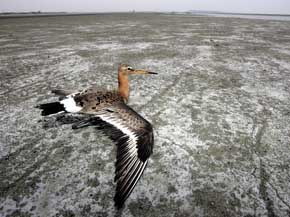 |
|
A willet wings over the dried remnants of Gwanghwalmyeon mud flats, now caked with salt deposits. Booan/Kim Tae-hyung
|
Seawall construction, ebb tides leading to their disappearance
GIMJAE, North Jeolla Province--On May 17, a yearly phenomena unfolded on the Eunpari mud flats here. There was a snipe on the mud flats, but although several people tried to approach it, the bird didn’t move. It was exhausted, its thin body and lusterless feathers testifying to the fact that the bird had just flown thousands of kilometers from Australia. In order to breed successfully this year, the snipe will have to double its weight through feeding at the Eunpari flats before taking flight for Siberia. But as the ten thousand snipes and plovers that gather each year at the flats were feasting on the abundant supply of shellfish they have always found here, unknown to them was the fact that the Eunpari tidal flats are doomed to disappear. Construction work on a seawall, designed to increase arable land in the region, was completed on April 21, and the Saemangeum tidal flats, which include the Eunpari flats and others, already do not look the same. The vast Geojeon mud flats, which were left vulnerable due to an ebb tide, seem to have dried up long ago. Their stiff surface is cracked and covered with white salt. The dry tidal flats remind one of a desert. Ju Yong-gi, the leader of an activist group opposed to the Saemangeum seawall project, said, “Sometimes the wind here is full of salty sand.” Seawater which used to move freely is now completely blocked, only able to enter the flats through a 540m-wide floodgate. Between the effects of the seawall and ebb tides, the flats have dried up rapidly, diminishing the catches of local fishermen. “Now it’s hard to earn just 20,000 won (20 USD) a day,” said Sin Hyeon-jeong, 58, a resident who used to dig for clams on the Geojeon tidal flats. He carried with him a mesh bag containing about 15 clams, his yield for the morning. “Now, I don’t know what to do to earn a living.”Many kinds of dead shellfish were seen scattered along a ditch. On a small island, dead clams, their mouths half open, were spread over a seemingly endless expanse. Flies buzzed continuosly. The Korea Rural Community & Agriculture Corporation hired local fishermen at 58,000 won a day for the past five days to help remove the dead shellfish from the tidal flats. Adrian Boyle, an Australian activist researching snipes and plovers on the Geojeon mud flats, said, “I feel sad and angry, because this may be the last time that I can watch such a grand sight.” Alan Eton, an Englishman who visited Saemangeum to observe birds, asked, “Saemangeum is known worldwide to bird watchers: Has it really ended?” Local fishing communities seemed resigned. Jeong Sun-mo, 53, a fisherman who owns three small boats, drank soju, or strong rice liquor, in broad daylight. “Now fish can’t come here because of the seawall,” he said. To make matters worse, a large red tide, or algae bloom due to fluctuating temperatures, appeared in the sea near Simpo and Munpo last week. The appearance of such a bloom spells trouble for many species of marine life in the area. In Saemangum, the only thing to do seems to be to wait for news about the government’s compensation plan for fishermen in the region. By Cho Hong-sup, Environmental reporter of the Hankyoreh





